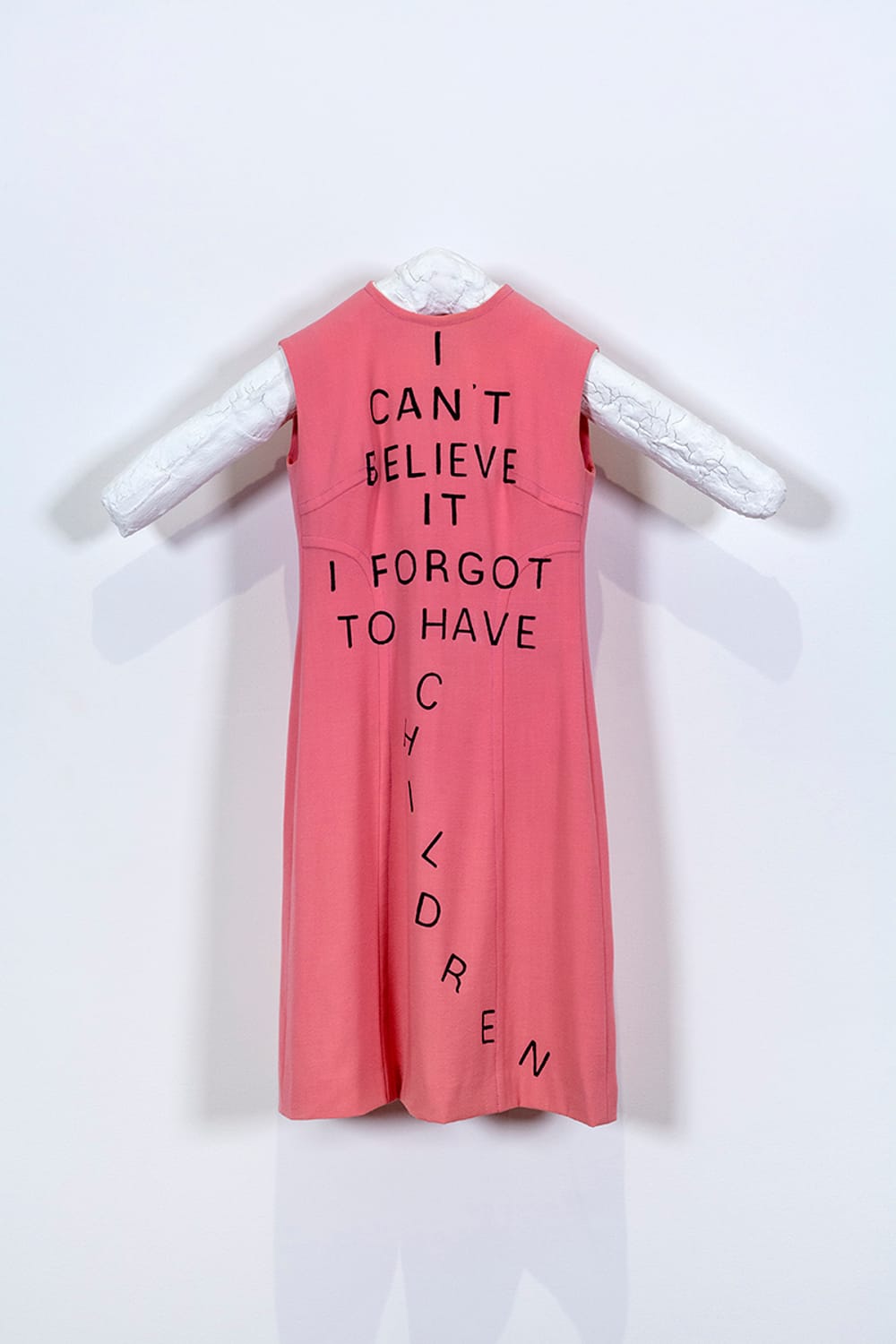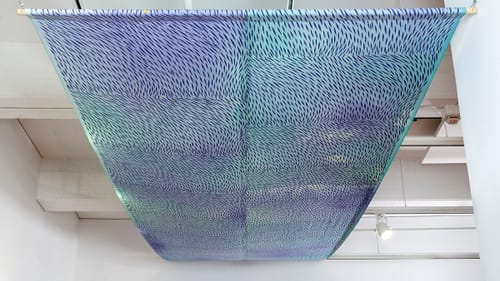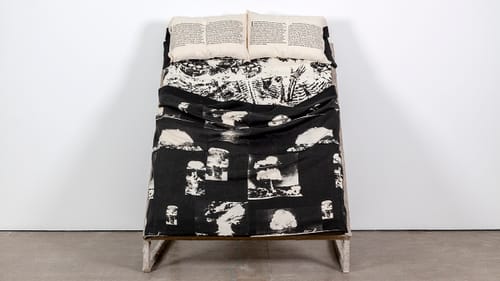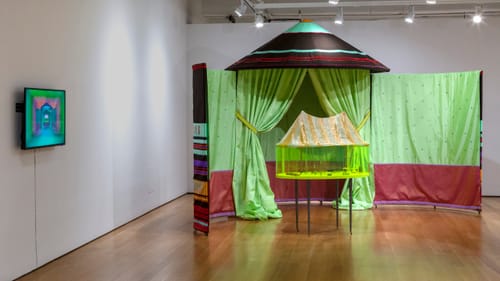Stay in the Loop
BSR publishes on a weekly schedule, with an email newsletter every Wednesday and Thursday morning. There’s no paywall, and subscribing is always free.
Celebrating 50 years of FWM Artists-in-Residence
The Fabric Workshop and Museum presents Soft/Cover

This is what happens when creatives collaborate. Soft/Cover displays almost 50 years of work from the Fabric Workshop and Museum’s (FWM) Artists-in-Residence program, in which artists from varied media explore fabric and screen-printing, supported by FWM studio artists. More than 65 works, produced from the 1970s to the present, including newly commissioned work from current residents, unfurl across galleries on three floors.
Thematically, Soft/Cover surveys work relating to the body. While the art on view includes a fair number of garments, they only begin to demonstrate the uses for screen-printed fabric. Works also provide or furnish shelter, assert political and social stands, and converse across galleries and generations.
Feminist bodies at work
New works by Jenny Walton and Aimee Koran speak to women’s ambivalence toward bearing and raising children. Walton, an illustrator/designer who examines connections between art and fashion, collects vintage clothing. Using a pink sleeveless dress from the 1960s as a notepad, Walton wrote I CAN’T BELIEVE IT I FORGOT TO HAVE CHILDREN (2024) in bold black print, dripping the last word down the A-line skirt.
Koran’s MSS (2024) acknowledges women who didn’t forget. Comparing childbearing and motherhood to space exploration, the Mama Space Suit is designed for the childcare mission. Equipped with a baby backpack, it has a wet-wipe dispenser on the outer left thigh, a pacifier attached by bungee cord, Velcro pocket flaps to accommodate breastfeeding, and patches signifying a proud sorority.
Setting the mood
From privacy to refuge, FWM residents have used screen-printed fabric to define space. Robert Kushner’s Rain Cabana (1989), an umbrella painted in autumnal colors and draped with burnished umber panels, works for beach or cloudburst.

Julia Chiang’s soothing canopy Going Under, Shhh (2024) welcomes visitors with a print composed of drifts of teardrops wafting like flocks of birds across a billowing blue sky. Chiang came to graphic and web design after a career as a pharmacist, and along the way, discovered the specialization “surface pattern designer,” to which she immediately gravitated: “I was amazed. There are actually real artist[s] and people behind all the fabric designs that I love! This realization blew my mind.”
Speaking of fabric and explosions, 1981 resident Robert Morris had the nuclear option on his mind while at FWM. Choosing the least likely vessel for these musings, Morris and the FWM team collaborated on Restless Sleepers/Atomic Shroud, bed linens that don’t inspire anything close to peaceful slumber. Imprints of black skeletons snuggle on the fitted sheet, under a top sheet bearing an album of black-and-white mushroom clouds. Sleepers in need of bedtime reading can peruse the pillowcases, fluffed up with passages speculating on methods of thermonuclear detonation.

Connecting across time
Brendan Fernandes’s 2024 curtains and soft sculptures, commissioned by the Pulitzer Arts Foundation, are designed to accompany an exhibition of work by 1978 FWM resident Scott Burton (1939-1989). Fernandes’s In Two (2024), long, screen-printed white muslin curtains, and Soft Touch I and Soft Touch II (2024), buckwheat shell-filled sculptures resembling polished stone, were inspired by Burton pieces. Fernandes, a dance composer and visual artist, has created dance scores referencing Burton’s practice and intends the works for use in performance.
Mildred Beltré Martinez’s Without Is As Within (2024) is a microcosm of Soft/Cover as a whole. It’s an open-ended peaked roof with four stools, two under the roof, two outside, all of it upholstered in silkscreened cotton sateen. The custom fabric was inspired by furniture that reminded the artist of her grandparents. The roof’s interior, and stools beneath it, are a dark, cozy green, while the exterior elements are covered in an antiqued floral print reminiscent of a 1960s slipcover. Roof and seats are all edged in silky, twisted fringe, an embellishment that seemed to appear on all living-room furniture in the middle of the 20th century. Visitors may sit on the stools, as two little girls happily did one afternoon as their father snapped a picture.
While creating the piece, Beltré Martinez was poised between thoughts of her past and her twins’ future as they prepared to leave for college. Knowing that detail makes it possible to see in the work references to transition and separation, home as a refuge from—and preparation for—the world, and the challenge of maintaining family across time and space.
Join the circus
In 1996, Maria Fernanda Cardoso needed a circus tent. The performance and visual artist had become fascinated by flea circuses, in which fleas walk tightropes, lift weights, perform high dives, and do acrobatics. She’d researched the phenomenon, which reached its height in the 19th century, going so far as to train fleas, cuing their tricks with light, heat, and breath. As ringmaster, Cardoso wore a tutu and cape for performances but came to FWM to create a sculptural installation to stand in when the live circus left town.

Thus Cardoso Flea Circus (1996) was born. It’s a section of a richly decorated, human-scale tent embracing a small vitrine topped with a peaked roof. The large tent glows in apple green nylon taffeta imprinted with fleas arcing across a galaxy of stars. Visitors can now also stroll around the big tent’s exterior, which wasn’t displayed in the original installation, to see lavish portraits of luminary mites Lulu, Tini y Tiny, and El Salto Mortal.
Inside, the glowing vitrine contains a filament of a tightrope stretched between toothpick-thin posts. Cannons smaller than C batteries stand ready to propel microscopic performers into the gold-and-white striped canopy, and a trampoline the size of a makeup compact is positioned to catch them. But the circus is quiet. Look closely for small specks on the high bar, perfectly balanced in perpetuity. A video by Cardoso and Ross Harley provides a sense of the live performance, including startling views of the artist, insect-like in magnifying goggles as she looms over her charges. This, too, is what happens when creatives collaborate.
At top: I CAN’T BELIEVE IT I FORGOT TO HAVE CHILDREN (2024) by Jenny Walton. (Photograph by Carlos Avendaño.)
What, When, Where
Soft/Cover. Through August 17, 2025, at the Fabric Workshop and Museum, 1214 Arch Street, Philadelphia. (215) 561-8888 or fabricworkshopandmuseum.org.
Accessibility
FWM’s main entrance is accessible for standard wheelchairs. All floors are accessible by elevator and have accessible, single-user restrooms. For more information, call 215-561-8888, ext. 233 (voice).
Sign up for our newsletter
All of the week's new articles, all in one place. Sign up for the free weekly BSR newsletters, and don't miss a conversation.
